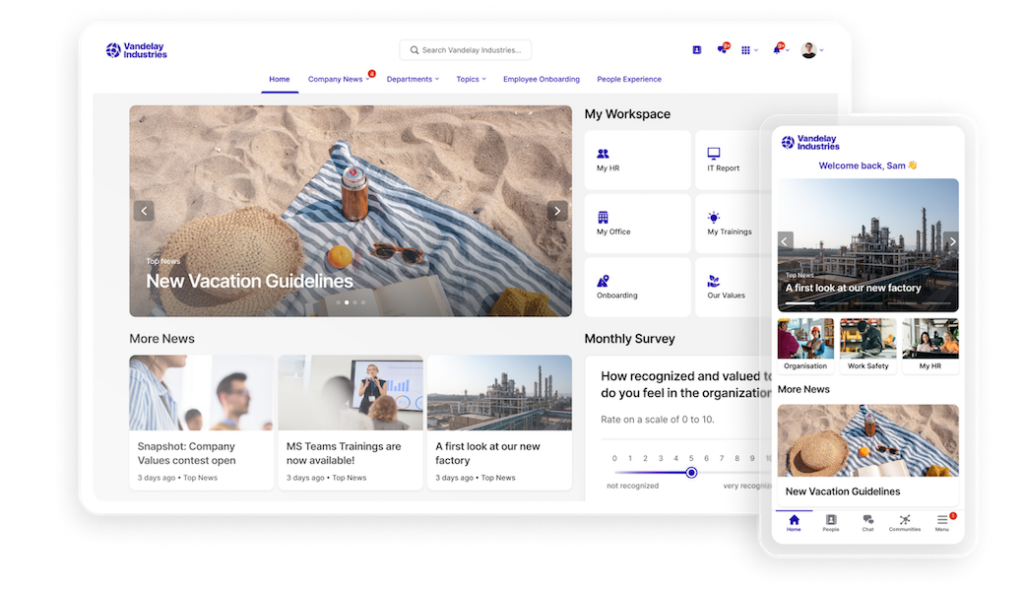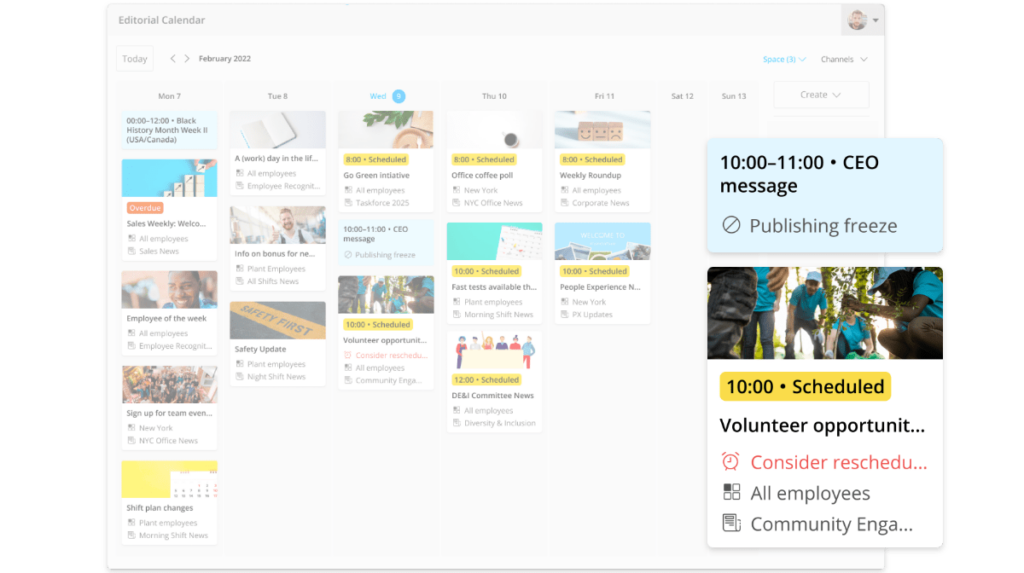When it comes to attracting and retaining top talent, a well-designed benefits package is key. The right perks and extras can have a significant impact on employees’ physical, mental, and financial well-being — which has a knock-on effect on employee satisfaction, engagement, and motivation.
The problem? Employers can only access all of these advantages if employees truly understand the benefits they’re being offered. We’ll discuss the importance of effective employee benefits communication in this guide.
Why employee benefits communication matters
Here are some of the reasons why effective employee benefits communication is crucial:
- Helps employees understand their benefits: Most obviously, effective employee benefits communication helps employees understand the benefits they have and how to access them. Benefits like healthcare and retirement plans can get pretty complex, and employees need clear information on how they work to take full advantage.
- Improves employee satisfaction and retention: Benefits are a key part of an employee’s overall compensation package. So it makes sense that they feel more valued and appreciated when they understand and use their benefits. Thai can lead to higher job satisfaction and even improve employee retention.
- Ensures compliance with regulations: Depending on your jurisdiction, you may be legally required to provide certain benefits to your employees. Clear communication about these offerings ensures employees understand their entitlements and demonstrates that your company is meeting its obligations.
- Reduces workload for HR and managers: If you don’t communicate effectively about your benefits program, employees are going to have questions. And that creates a lot of extra work for managers and HR. Making employee benefits a key part of your internal communication strategy can relieve some of that pressure by empowering employees to find the answers they need on their own.
Challenges in communicating employee benefits (and how to overcome them)
Most employers want employees to understand and utilize their benefits — that’s why they’re there, after all. So, why is it often so difficult to effectively communicate about employee benefits? Here are three challenges you might be facing (and how to address them).
Problem #1: Employees are overloaded with information at onboarding
The onboarding process is the most common time to inform employees about the various benefits they’re entitled to. The problem is, it’s also a moment when new employees are completely overloaded with information — which makes it easy for crucial messages to get lost in the shuffle.
To avoid this, it’s best to provide basic information about benefits in a place employees can easily access whenever they need to, like your employee handbook. You should also reinforce the message periodically with repeat content and reminders throughout the employee journey.
Problem #2: Employees don’t know where to look for information
Another common problem is that employees simply don’t know where to look for reliable information about their benefits package. This leads to frustration for employees, and increased workloads for HR and line managers, who must constantly field repeated questions.
The easiest solution is to create a single source of truth about your benefits package that employees know they can trust. For example, you could set up a dedicated page on your company intranet. Ensure employees know about this resource so they can find answers independently when they need it.

Problem #3: Employees know what benefits they’re entitled to, but not how they work
As mentioned, employee benefits can get pretty complex. Even if employees are aware of the benefits the company offers, they may not understand how these things work in practice. Again, this lack of clarity can result in additional questions and wasted time for HR and managers.
There’s no one simple solution to this: it basically comes down to having a thorough, well-thought-out employee benefits communication strategy (in other words, the subject of this whole article). But certain things, like including visual aids and examples in your communications and tailoring the message for certain groups of employees, can help with understanding.
Choosing the right channels for communicating employee benefits
The channels you use to communicate employee benefits to your team are an important part of your overall strategy. Your goal should be to meet employees where they are, providing the information they need in a format they can easily access and understand. Here are some possible communication channels you could use:
- Intranet: Creating a dedicated page on your company intranet for employee benefits communication is a good first step in an effective strategy. This creates a single source of truth that employees know they can trust. It should include important information on the benefits your company offers, answers to common questions, and links to any relevant resources or providers. Just be sure to keep this page updated to ensure it’s always accurate.
- Employee app: Using your employee app for employee benefits communication ensures the message gets through to all employees — including your remote and deskless team members. It also provides a convenient way for employees to quickly check aspects of their benefits package from wherever they are, without having to log onto a computer (or bother their line manager).
- Newsletter: Sending out a regular email newsletter is a great way to keep employees in the loop about their benefits. You could use it to highlight underused aspects of your package, let employees know about important changes and updates, and even share stories of employees using their benefits in creative ways. Just don’t overdo it, or you risk overwhelming your team — once a month or quarter is probably enough.
- Digital signage: Using digital signage around your workplace to share key information can help to reinforce messages you’ve sent out via email or other methods. It also allows deskless workers, who may not have access to your intranet or newsletters, to better understand their benefits. Given the format, it’s best to keep messaging as clear and concise as possible and to use visual aids to help with understanding.
- SMS: SMS notifications are best used for time-sensitive, short-form messages. For example, you could use SMS to send reminders about important dates, such as enrollment periods or deadlines. This helps keep employees in the loop without taking too much of their time. Since they’re delivered directly to employees’ work or personal cell phones, SMS notifications are also a good way of getting key info to deskless workers.
- Video: Creating video resources that walk employees through their benefits can be a valuable way of getting the information across. It’s particularly helpful to employees who are visual learners, as they may find it easier to retain information presented in this format. Making a video is also an opportunity to inject a bit of your brand’s personality into your employee benefits communications — which can help make them more engaging.
For best results, you’ll probably need to reinforce the message by using more than one channel to communicate.
How to communicate employee benefits: a step-by-step guide
Ready to start putting together your employee benefits communication strategy? Here are the steps to follow.
- Identify key touchpoints and create a communication calendar
Employee benefits communication isn’t something you can do once and then forget about. Instead, it should be built into every stage of the employee lifecycle. The first step of putting your plan together is identifying key touchpoints where you’ll check in with employees about their benefits.
One of the most obvious moments to highlight benefits to employees is during the onboarding process. However, it’s also a good idea to plan for communications:
- When an employee is promoted or moves position
- After the annual compensation review is completed
- On work anniversaries or other key moments
In addition, you should also plan to reinforce the most important information at regular intervals unrelated to your employees’ journeys with your company. For example, you could send a monthly newsletter that keeps employees abreast of any changes and highlights particular aspects of your benefits package. Creating a calendar to plan these communications is a good first step.

- Select the right tools and communication channels
Next, you’ll need to determine which channels you’ll use to communicate about employee benefits and the tools you’ll need to develop and distribute those communications. As discussed, you might want to share communications through channels such as:
- An intranet
- Email newsletters
- An employee app
- Digital signage
- SMS notifications
To keep things efficient, it’s a good idea to look for tools that combine several of these functions. For example, Staffbase is an all-in-one employee communication platform that includes an intranet, employee app, newsletters, digital signage, and even SMS notifications. Using Staffbase, you can manage all of your communications through one central platform and deliver them through the channels that make the most sense for each employee.
- Develop messaging for employees
Developing the actual messages you’ll share with employees at different stages is the next step. This might include:
- Putting together static information to share on your intranet or in your employee handbook
- Creating a benefits explainer pack for new employees
- Designing a template (or several) for regular newsletters about your benefits program
- Coming up with short-form messages to display on digital signage throughout your workplace
The tone of the messaging you put together depends on your company culture. In general, it’s a good idea to keep things as simple and concise as possible so it’s easy for employees to understand.
- Begin delivering information through various channels
Delivering communications about your benefits package is an ongoing process, which will look different depending on the tools and communication channels you’ve decided to use. As a basic guide, your strategy should include:
- Sharing static benefits information in your employee handbook or on an intranet page. This will form the central hub of your employee benefits communications and should be a reliable source of truth that employees can trust.
- Sending out specific communications at key moments in the employee journey, such as onboarding, promotions, and work anniversaries.
- Sending communications at regular intervals to share important updates and reminders, as well as reinforcing key messages. This could be a monthly or quarterly newsletter.
Together, these three elements form a basic employee benefits communication plan. You could also supplement your strategy with communications through other channels, such as SMS notifications or digital signage.
- Gather feedback from employees
Communication is a two-way street. And understanding how employees feel about your benefits program is an important part of employee benefits communication. For this reason, it’s a good idea to build in opportunities for employees to provide their feedback as you’re putting your employee benefits communication strategy together.
Sending out an annual survey to gather employees’ thoughts about your benefits offering is a good starting point. If you want to dig deeper, you could set up focus groups to discuss any issues you’ve uncovered. For example, employees may feel that some benefits are less valuable than others or wish you provided certain benefits that aren’t currently part of your offering. They may also have feedback on the process of accessing certain benefits. All of this is useful information to have as you hone and adapt your benefits offering.

Best practices for communicating employee benefits
While there’s no one right way to communicate about your employee benefits package, there are certain best practices that can give your strategy a better chance of success. Here are a few tips to keep in mind:
- Keep things clear and simple: Effective employee benefits communication should leave employees with a clear understanding of their benefits and how to access them. To achieve this, keep your communications as clear and understandable as possible. Avoid technical jargon and complex terminology and break down information into smaller, digestible chunks to aid understanding.
- Use visual aids and examples: Incorporating visual elements like pictures, diagrams, and flowcharts can make your employee benefits communications even easier to understand. It’s also a good idea to provide concrete examples — particularly for complex benefits like retirement plans. This can help employees to understand their benefits in their full context.
- Make communications as relevant as possible: When communicating about employee benefits, you need to make sure the messages you’re sending are as relevant as possible to the people receiving them. As a first step, that means segmenting your email list by benefit plan or eligibility. You may also want to design unique templates for each department.
- Tailor your messaging for different groups: You should also think about how to make content resonate with different audiences. For example, younger employees may be less motivated to engage with content related to 401(k)s, simply because the idea of retirement feels very distant to them. Ensuring your messaging hits home with all employees requires some creative thinking.
- Use multiple channels: Using a variety of channels to communicate about employee benefits ensures the message gets through to everyone. Employees may also appreciate content in different formats depending on their immediate needs. For example, they may look to your intranet for basic benefits information, but appreciate email newsletters keeping them in the loop about any updates.
- Measure the impact of your employee benefits communications: The best way to figure out if your employee benefits communication is working? Ask your employees. Consider sending out regular surveys to find out what employees think about the communications they’ve received and how well they feel they understand your benefits offering. You can also use your intranet platform’s built-in analytics to find out which content people are engaging with the most.
Sample email template for communicating employee benefits
Sending out a regular newsletter about your benefits program is a good way to keep employees informed and remind them of the benefits they’re entitled to. But what might that newsletter actually look like? Below, we’ve shared a short example you can use — just fill in the blanks with the relevant information for your company.
Keep in mind that the tone of the emails you send is completely dependent on the norms at your organization. We’ve kept this one quite simple, but feel free to dial the formality up or down if that’s more in-fitting with your company culture.
Here’s the template:
Subject line: Your regular employee benefits update
Dear [Employee],
Welcome to your [monthly/quarterly] employee benefits update. Here’s everything you need to know about accessing and using your benefits at [company].
Are you using your benefits?
First, here’s a quick reminder of the benefits we offer at [company]:
- Benefit #1, e.g. Medical, dental, and vision insurance coverage
- Benefit #2, e.g. Paid time off, including vacation days, sick leave, and holidays
- Benefit #3, e.g. Retirement savings plans including matching 401(k) contributions
- Benefit #4, e.g. Employee assistance program (ESP) including counseling service
- Benefit #5, e.g. Learning and development opportunities
Where to find more information:
Need more info on any of the benefits listed above? You can find everything you need to know at [link to intranet page].
Updates and changes
[Insert info about latest changes to benefit program]
Employee stories
[Insert story about an employee using a benefit in an unusual or exciting way, including a testimonial]
Any questions?
Have questions about your benefits and how to access them? First, check the information on [intranet page]. If you can’t find the answer, reach out to [HR contact name] at [HR contact information] for help.
Warm regards,
[Email signature]
Creative ways to communicate employee benefits with Staffbase
Staffbase is an all-in-one communications cloud that allows employers to connect with all employees, whether they’re in the office, working remotely, or on the frontline. Here are a few unique ways you could use Staffbase to improve your employee benefits communications:
- Share employee stories and testimonials: Benefits are much more meaningful when employees can see how they’re used. You can use Staffbase to share stories of employees who have used your benefits in unusual or interesting ways. For example, maybe they used their medical benefits for an expensive procedure like laser eye surgery, or their vacation time to go on an exciting trip.
- Create quizzes to gamify employee benefits communication: Employees are much more likely to remember information when it’s presented in an engaging, interactive format. Creating a quiz that tests employees’ knowledge of their benefits can help get across the necessary information in a fun and surprising way.
- Use pulse surveys to gather quick feedback: Understanding what your employees think of your benefits program is a key part of employee benefits communication. Sending out pulse surveys focused on benefits is an easy way to get a rolling view of employee opinions and how they change over time.
- Create personalized journeys for each employee: Tools like Staffbase also allow you to create personalized journeys for each employee so you can get the exact right content in front of them at the right time. For example, you might send a new employee a link to your benefits info on their first day, then send a personalized checklist to help them sign up for services within the next few days. You could then follow up with a survey after a certain period, like three or six months.
Final thoughts
Employee benefits are key to employee satisfaction, engagement, and retention. But they’re only effective if employees are aware of the benefits that are available and understand how to access them. A strong benefits communication strategy supported by the right tools is essential to bridging this gap.
When employees clearly understand their benefits, they’re empowered to use them to their full advantage. This not only enhances well-being in various ways but also sends a message that your organization values them as people, not just numbers on a spreadsheet. This can foster greater satisfaction and motivation, making your benefits program a true investment in your people and their long-term loyalty to your organization.







